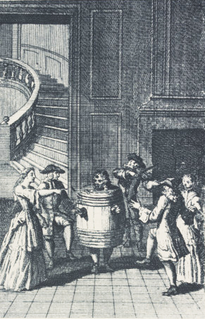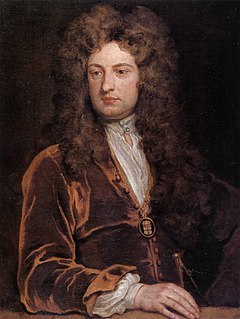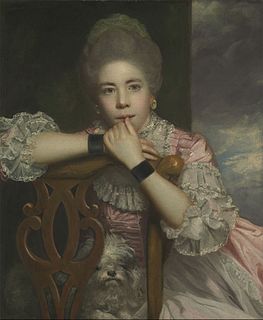This article needs additional citations for verification .(November 2020) |
The Innocent Mistress is a comedy written by Mary Pix, first performed in 1697.
This article needs additional citations for verification .(November 2020) |
The Innocent Mistress is a comedy written by Mary Pix, first performed in 1697.
Sir Charles, a younger son with no estate, is unhappily married to the wealthier, older and "ill-bred" Lady Beauclair. Lady Beauclair is supposedly a widow, and like her daughter Peggy, is “an ill-bred woman”. Their marriage has not been consummated. He instead falls in love with his niece's friend 'Bellinda', whose real name is in fact Marianne. She is in hiding after escaping a forced marriage, and although she loves Sir Charles, she refuses to become his mistress. At the end of the play it is revealed that Lady Beauclair's first husband, Mr Flywife, is alive and back to London after several years in Jamaica. Sir Charles' marriage to Lady Beauclair is legally invalid, so he and 'Bellinda' are free to marry.
Sir Charles' niece Mrs. Beauclair, 'an independent woman', attempts to reform Sir Francis Wildlove from his initial rakishness. Wildlove finally changes his attitude and reveals his true feelings for Mrs Beauclair when he mistakenly thinks she has married another man.
Several other courtships take place during the play. Arabella is a wealthy young woman whose fortune and person are controlled by Lady Beauclair and her brother Cheatall. With the help of Lady Beauclair's clever servant Eugenia, she is able to marry her suitor Beaumont, 'an honest country gentleman'. Eugenia marries her fellow servant, Gentil. Finally, the social parasite Mr Spendall tricks Peggy into believing he is rich, and they also marry. For their part, Lady Beauclair and Mr Flywife now have to pay for their mistakes by living together again.
The play was first performed in 1697 at Little Lincoln's Inn Fields. The cast included Thomas Betterton as Sir Charles Beauclair, John Verbruggen as Sir Francis Wildlove, John Hodgson as Beaumont, John Bowman as Spendall, John Freeman as Lyonell, William Bowen as Cheatall, Joseph Harris as Gentil, Cave Underhill as Flywife, Elizabeth Barry as Bellinda, Anne Bracegirdle as Mrs Beauclair, Elinor Leigh as Lady Beauclair and Abigail Lawson as Euginia. [1]
The Innocent Mistress was popular with audiences when released. [2]
Jose Yebra suggests that the play mirrors contemporary 'anxieties and fears in view of the overall change undergone by the English society in late seventeenth century... Once the Carolean sexual libertinism abated, the Augustan stage became more reactionary and morally repressive. However, The Innocent Mistress is rather ambiguous in this respect. It combines the conservative traits patriarchal Augustan theatre demanded from female writers with Pix’s pro-female discourse that contests, albeit timidly, women’s discrimination. [3]

"Restoration comedy" is English comedy written and performed in the Restoration period of 1660–1710. Comedy of manners is used as a synonym for this. After public stage performances were banned for 18 years by the Puritan regime, reopening of the theatres in 1660 marked a renaissance of English drama. Sexually explicit language was encouraged by King Charles II (1660–1685) personally and by the rakish style of his court. Historian George Norman Clark argues:
The best-known fact about the Restoration drama is that it is immoral. The dramatists did not criticize the accepted morality about gambling, drink, love, and pleasure generally, or try, like the dramatists of our own time, to work out their own view of character and conduct. What they did was, according to their respective inclinations, to mock at all restraints. Some were gross, others delicately improper.... The dramatists did not merely say anything they liked: they also intended to glory in it and to shock those who did not like it.
Sanditon (1817) is an unfinished novel by the English writer Jane Austen. In January 1817, Austen began work on a new novel she called The Brothers, later titled Sanditon, and completed eleven chapters before stopping work in mid-March 1817, probably because of illness. R.W. Chapman first published a full transcription of the novel in 1925 under the name Fragment of a Novel.

The Provoked Wife (1697) is the second original comedy written by John Vanbrugh. It made its first appearance in Lincoln's Inn Fields in May, 1697. The often-repeated claim that Vanbrugh wrote part of his comedy The Provoked Wife in the Bastille is based on allusions in a couple of much later memoirs, but is regarded with some doubt by modern scholars. It is different in tone from his first play, the largely farcical The Relapse, and adapted to the greater acting skills of the new company of actors chosen for its premiere, who walked out not long before in a dispute with management. The actors' cooperative boasted the established star performers of the age, and Vanbrugh tailored The Provoked Wife to their specialties. While The Relapse had been robustly phrased to be suitable for amateurs and minor acting talents, he could count on versatile professionals like Thomas Betterton, Elizabeth Barry, and the rising young star Anne Bracegirdle to do justice to characters of depth and nuance.

Mary Pix was an English novelist and playwright. As an admirer of Aphra Behn and colleague of Susanna Centlivre, Pix has been called "a link between women writers of the Restoration and Augustan periods".

He Knew He Was Right is an 1869 novel written by Anthony Trollope which describes the failure of a marriage caused by the unreasonable jealousy of a husband exacerbated by the stubbornness of a wilful wife. As is common with Trollope's works, there are also several substantial subplots. Trollope makes constant allusions to Shakespeare's Othello throughout the novel. Trollope considered this work to be a failure; he viewed the main character as unsympathetic, and the secondary characters and plots as much more lively and interesting, but it is one of his best known novels. It was adapted for BBC One in 2004 by Andrew Davies.
Wit at Several Weapons is a seventeenth-century comedy of uncertain date and authorship.

Mary Saunderson (1637–1712), later known as Mary Saunderson Betterton after her marriage to Thomas Betterton, was an actress and singer in England during the 1660s and 1690s. She is considered one of the first English actresses.
Camilla, subtitled A Picture of Youth, is a novel by Frances Burney, first published in 1796. Camilla deals with the matrimonial concerns of a group of young people: Camilla Tyrold and her sisters, the sweet tempered Lavinia and the smallpox scarred Eugenia, and their cousin, the beautiful Indiana Lynmere—and in particular, with the love affair between Camilla herself and her eligible suitor, Edgar Mandlebert. They have many hardships, however, caused by misunderstandings and mistakes, in the path of true love.
Katherine Corey was an English actress of the Restoration era, one of the first generation of female performers to appear on the public stage in Britain. Corey played with the King's Company and the United Company, and had one of the longest careers of any actress in her generation. In "The humble petition of Katherine Corey", she stated that she "was the first and is the last of all the actresses that were constituted by King Charles the Second at His Restauration."

Love for Love is a Restoration comedy written by British playwright William Congreve. It premiered on 30 April 1695 at the Lincoln's Inn Fields Theatre. Staged by Thomas Betterton's company the original cast included Betterton as Valentine, William Smith as Scandal, John Bowman as Tattle, Thomas Doggett as Ben, Samuel Sandford as Foresight, William Bowen as Jeremy, John Freeman as Buckram, Anne Bracegirdle as Angelica, Elizabeth Bowman as Mrs Foresight, Elizabeth Barry as Mrs Frail, Elinor Leigh as Nurse and Abigail Lawson as Jenny.

Sophia is a novel published in 1762 by Charlotte Lennox, a British novelist best known for her 1752 satirical novel The Female Quixote. Originally published in Lennox's periodical The Lady's Museum as Harriet and Sophia between 1760-1, this novel is only the second British novel to be serialized in a magazine, and the first one to be published this way by a woman.
John Bowman (1651–1739) was a British stage actor. He began his career in the Duke's Company at the Dorset Garden Theatre. In 1692 he married Elizabeth Watson, who acted under the name Elizabeth Bowman. He later switched to act at the Drury Lane Theatre. He is also referred to as John Boman.
William Bowen (1666–1718) was a British stage actor. He was part of the United Company from 1689. For a time, he became known for his comic roles. He was fatally wounded in a duel with fellow actor James Quin in 1718.
Elizabeth Willis (c.1669-1739) was a British stage actress.
Elinor Leigh was a British stage actor of the seventeenth century.
The Deceiver Deceived is a comedy written by Mary Pix, first performed in 1697.
Elizabeth Bowman was an English stage actor of the seventeenth and early eighteenth century. The daughter of Sir Francis Watson, 1st Baronet she was adopted by the actor manager Thomas Betterton. In 1692 she married John Bowman and began acting at Drury Lane the following year as Mrs Bowman. She was a member of the United Company until 1695 then joined Betterton's breakaway at the Lincoln's Inn Fields Theatre.
Abigail Lawson was an English stage actor of the seventeenth and early eighteenth century. She was a member of the United Company, making her first known appearance in The Marriage-Hater Matched by Thomas D'Urfey in 1692. From 1695 she was part of Thomas Betterton's breakaway company at the Lincoln's Inn Fields Theatre.
John Hodgson was an English stage actor of the late seventeenth century. He joined the United Company in 1688 and his first recorded appearance was in The Treacherous Brothers at Drury Lane in 1690. In 1695 he was one of several actors who broke away to join Thomas Betterton's new company at Lincoln's Inn Fields. His name is sometimes written as Hudson. He was married to the singer Mary Hodgson.
Joseph Harris (c.1650–1715) was an English stage actor and playwright. His earliest known performance was in the United Company's The Bloody Brother in 1685. Earlier mentions an actor named Harris are likely to refer to an earlier lesser-known actor William Harris or even the celebrated Restoration performer Henry Harris. He remained with the United Company until 1695 when he joined Thomas Betterton's breakaway company at the Lincoln's Inn Fields Theatre. He acted there until around 1705, although some reports have him still acting as late as 1715.